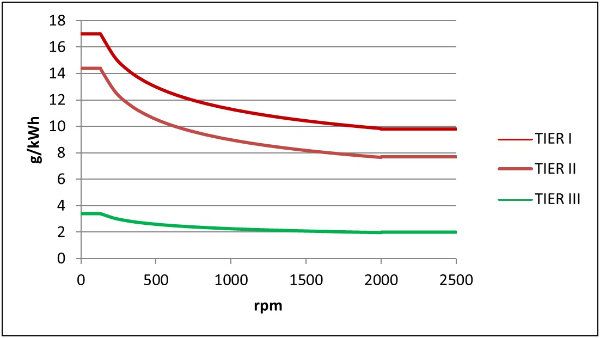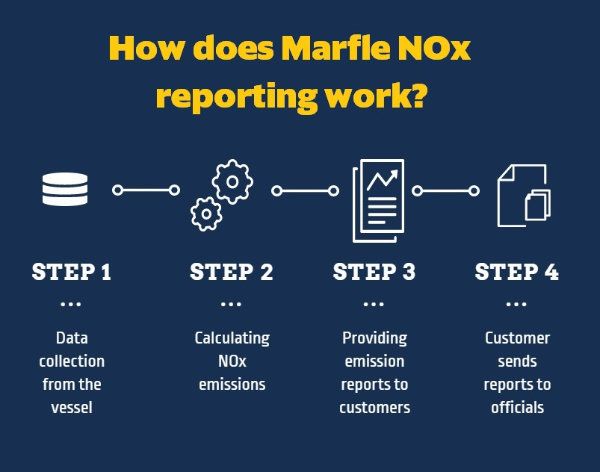Emissions monitoring and reporting automation by Marfle
Nitrogen oxides (NOx) emissions are responsible of air pollution, algal bloom in the sea and formation of ground level ozone that harms wildlife. Only in Norway, shipping and fishing industries account for one third of NOx emissions in the country.
International Maritime Organization (IMO) designated North Sea and the Baltic Sea as NOx Emission Control Areas (NECA) starting from January 1, 2021. All passing ships through these areas must comply with IMO’s Tier III NOx control standards by this date. This means that new ships operating in these waters will need to reduce their NOx emissions by around three-quarters.

Tier III regulations demand a 80% reduction in NOx emissions of marine diesel engines compared to Tier I. (Source: Danish Maritime Authority)
Without question, Norway is the leading country in NOx mitigation. The country imposed NOx tax in 2008 and businesses can be exempt of this as long as they reduce their NOx emissions by a certain amount. Moreover, companies founded a NOx fund which allows them to pay into the fund at a lower rate than the tax, and use the Fund as an investment source for NOx reducing technologies. They may apply for financial support up to 80% coverage of their investment.
Fund members are obliged to submit a NOx tax report to the Fund each quarter. Different kinds of information including AIS-data of vessels are being used for verification checks. The Fund is so successful that it serves as a model to other countries like UK. There was a significant decline in NOx emissions by 4.2% in 2017 compared to the year before.
In addition to Norway’s NOx regulations, European Union and IMO imposed regulations for reducing greenhouse gases in maritime industry. EU put a mandatory MRV Regulation into effect on 29 April 2015. This creates an EU-wide legal framework for the monitoring, reporting and verification of CO2 emissions in the industry. IMO’s similar system that was adapted in July 2014 compels ship owners to develop a system for data collection, data analyses and decision making regarding their fuel consumption.
Here, Marfle comes into play. Marfle Fleet Analytics allows workboat owners to monitor their NOx and CO2 emissions and automatize their reporting process without using any additional equipment other than the system. It shows the emissions information in a user-friendly interface and allows users to extract automated reports.

Norwegian marine services company Bukser og Berging uses the system in their pilot boat fleet. System calculates NOx and CO2 emissions that was done manually before and automate company's reporting process. Users can easily see monthly, quarterly and annually NOx and CO2 emissions, and compare different vessels’ performance in a user-friendly interface.
Sources
European Commission. Air pollution from the main resources / Air emission from maritime transport, https://ec.europa.eu/environment/air/sources/maritime.htm
Danish Maritime Authority. Nitrogen oxide (NOx), https://www.dma.dk/Vaekst/MiljoeKlima/KvaelstofOxid/Sider/default.aspx
Norwegian Maritime Authority, (2016). Emissions to air, https://www.sdir.no/en/shipping/vessels/environment/prevention-of-pollution-from-ships/emissions-to-air/
Department for Transport – GOV.UK, (2019). Clean Maritime Plan, https://assets.publishing.service.gov.uk/government/uploads/system/uploads/attachment_data/file/815664/clean-maritime-plan.pdf
Environmental Defence Fund. The Norwegian NOx Fund, https://europe.edf.org/file/375/download?token=2fsAHP74
DNV GL, (2019). Technical Advisory for the Norwegian NOx Fund, https://www.dnvgl.com/maritime/advisory/technical-advisory-norwegian-nox-fund.html
DNV GL. EU MRV and IMO DCS, https://www.dnvgl.com/maritime/insights/topics/EU-MRV-and-IMO-DCS/index.html
LEXOLOGY. Maritime GHG emissions: The Paris Agreement, an IMO MRV and “market-based measures” – looking forward to MEPC 69, https://www.lexology.com/library/detail.aspx?g=9e70ee88-b4e9-4fce-8943-cb2dfffc9536